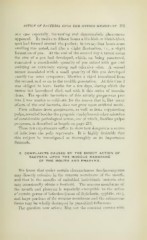Page 323 - My FlipBook
P. 323
ACTION OF BACTERIA UPON THE MUCOUS MEMBRANE. 295
one case especiallv, interesting and characteristic plienomena
appeared. In twelve to fifteen hours a blackish or bluish-black
spot had formed around the pocket; in twenty-four hours some
swelling was noted, and also a slight fluctuation, i.e., a slight
formation of pus. At the end of the second day a tumor about
the size of a pea had developed, which, on being punctured,
evacuated a considerable quantitj' of pus mixed with gas and
emitting an extremely strong and offensive odor. A second
mouse inoculated with a small quantity of this pus developed
exactly the same symptoms; Ukewise a third inoculated from
the second, and so on to the twelfth generation. At this time I
was obliged to leave Berlin for a few days, during which the
mouse last inoculated died, and with it this series of inocula-
tions. The specific bacterium of this strictly gangrenous pro-
cess I was unable to cultivate, for the reason that it, like many
others of the oral bacteria, does not grow upon artificial media.
Pure cultures from gangrenous, as well as from suppurating
pulps, revealed besides the pyogenic staphylococci other microbes
of considerable pathological action, one of which, Bacillus pulpse
pyogenes, is described at length on page 273.
These few experiments suffice to show how dangerous a source
of infections the pulp represents. It is highly desirable that
this subject be investigated as thoroughly as its importance
demands.
3. COMPLAINTS CAUSED BY THE DIRECT ACTION OF
BACTERIA UPON THE MUCOUS MEMBRANE
OF THE MOUTH AND PHARYNX.
We know that under certain circumstances Saccharomycetes
may directly colonize in the mucous membrane of the mouth,
and that in the mouths of enfeebled individuals bacteria also
may occasionally obtain a foothold. The mucous membrane of
the mouth and pharynx is especially susceptible to the action
of certain germs of infection (those of diphtheria, syphilis, etc.),
and large portions of the mucous membrane and the submucous
tissue may be wholly destroyed by parasitical influences.
The question now arises: May not the constant contact with


